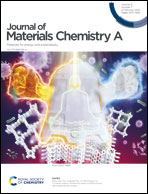Fabrication of stable perovskite solar cells with efficiency over 20% in open air using in situ polymerized bi-functional additives†
Abstract
Generally, detrimental defects on perovskite surface and grain boundaries (GBs) directly impede the further enhancement of both the photovoltaic performance and long-term stability of perovskite solar cells (PSCs). Herein, 2,2,2-trifluoroethyl methacrylate (TFEMA), a crosslinked polymerizable bi-functional defect passivation agent along with an initiator, is incorporated into the antisolvent. Via an in situ polymerization strategy motivated during the film annealing treatment, the formed TFEMA dimers will be clustered at the surface and GBs. The polymerized bulkier molecules via C![[double bond, length as m-dash]](https://www.rsc.org/images/entities/char_e001.gif) O⋯Pb coordination bonds and N–H⋯F hydrogen bonding interactions can simultaneously neutralize under coordinated lead ions and improve the device stability. Moreover, the TFEMA dimers left on the top of the perovskite active layer that acts as a buffer layer can suppress interfacial nonradiative recombination and tune energy-level alignment between the layers. Consequently, the device fabricated in open air acquires a champion power conversion efficiency of 20.18%, along with enhanced stability, where 85.5% and 82.7% of the original efficiency is maintained after consecutive 300 h thermal annealing process and 2400 h shelf storage, respectively. By applying an in situ polymerization strategy to the PSCs, we corroborate the effectiveness of this methodology to achieve the purpose of tremendous augments in efficiency and stability.
O⋯Pb coordination bonds and N–H⋯F hydrogen bonding interactions can simultaneously neutralize under coordinated lead ions and improve the device stability. Moreover, the TFEMA dimers left on the top of the perovskite active layer that acts as a buffer layer can suppress interfacial nonradiative recombination and tune energy-level alignment between the layers. Consequently, the device fabricated in open air acquires a champion power conversion efficiency of 20.18%, along with enhanced stability, where 85.5% and 82.7% of the original efficiency is maintained after consecutive 300 h thermal annealing process and 2400 h shelf storage, respectively. By applying an in situ polymerization strategy to the PSCs, we corroborate the effectiveness of this methodology to achieve the purpose of tremendous augments in efficiency and stability.



 Please wait while we load your content...
Please wait while we load your content...